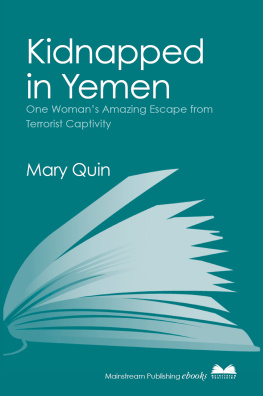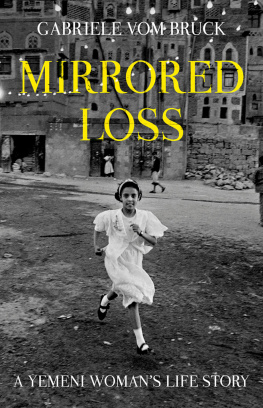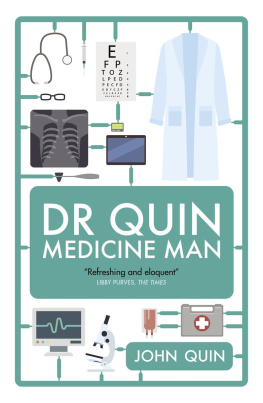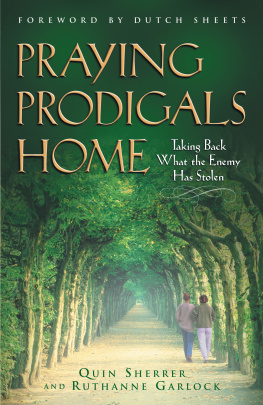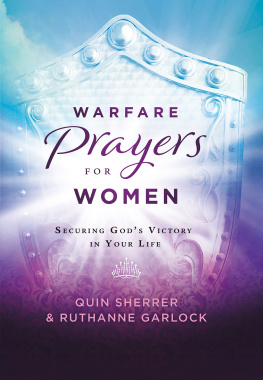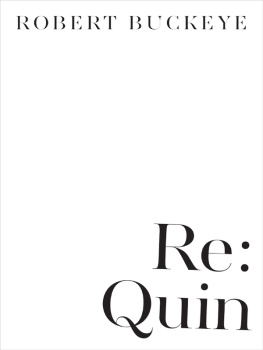Contents
About the Author
Mary Quin holds a Ph.D. in materials science and engineering from Northwestern University and an MBA from Harvard. After an 18-year career in corporate America, she founded and runs an organic retail company, Tuliqi LLC. Mary now divides her time between Anchorage, Alaska, and Auckland, New Zealand.
KIDNAPPED IN YEMEN
One Womans Amazing Escape from Terrorist Captivity
Mary Quin

For Andrew, Peter and Ruth,
who did not live to tell their stories.
Acknowledgements
This book is about a journey to Yemen. It is also about a journey through four years of my life. I did not make this journey alone. A remarkably diverse group of people has been there to offer advice, information, perspective, expertise, support, friendship, memories and love. It would not have been possible to make this journey or to write and publish this book without their help.
In the early days of writing the manuscript, it was my US literary agent, Andrea Pedolsky, who taught me the techniques of blending personal experience, research and secondhand reports into an integrated story. Andrea believed in me as a writer and believed my story deserved to be published. This book would not have happened without her patient coaching, encouragement and advice.
I would like to thank the team at Mainstream Publishing for their editing, designing, proofing and production work. Special thanks to my editor, Ailsa Bathgate, whose careful review of the manuscript resulted in improvements and clarification of the story.
My writers group in Anchorage Karen Benning, Dawnell Smith, Judy Stoll and Tara Witterholt provided valuable feedback during the many months I spent researching and writing this book. Our monthly Sunday meetings were a wonderful source of friendship and humour.
Many people provided me with leads and information that helped me to piece together the events that preceded and followed the kidnapping. In particular I would like to thank Peter Bergen, Sheila Caripico, Nick Childs, Brad Deardorff, Max and Nasrine Gross, Lisa Hughes, Fred Humphries, Duncan Jarrett, Mark Katz, Mike Marks, Malcolm Nance, Kevin OShea, Robert Young Pelton, Anna Wuerth and my ArabicEnglish translator. Pat Morris and Margaret Thompson were particularly helpful in sharing their recollections of the kidnapping and filling in details I had missed.
My return research trip to Yemen would not have been possible without the generous support and assistance of former Yemeni Prime Minister Abdel Karim al-Iryani, and Yemens ambassador to the United States, Abdulwahab Abdulla al-Hajjri. For spending time meeting with me and answering my many questions I would like to thank Badr Basunaid, Khaled Tarik, Bashraheel H. Bashraheel, Mustafa Rajamanar, Martin Lamport and Barbara Bodine. The governors of the provinces of Aden and Abyan were prominent among the Yemeni government leaders and officials who assisted me in my search for information. Special thanks also to Sameer Haj and to Mohammed Mozeid, who facilitated my meetings and transportation in Yemen, and to the Yemeni soldiers and police who ensured my safe travel.
This book recounts my best recollections, records and research of the kidnapping and the context in which it happened. I recognise that some of my tourmates may remember certain aspects differently, but I trust this account will provide new insights and contribute to a sense of closure for them and their families. The remarkable composure and courage demonstrated by all of the hostages in the face of violent death were a great source of strength to me and for that I extend my deepest thanks and admiration to them all Andrew, Brian, Catherine, Chris, Claire, David, Eric, Gill, Laurence, Margaret T., Margaret W., Pat, Peter, Ruth and Sue.
While many have questioned the wisdom of the rescue operation, it is nonetheless true that dozens of Yemeni soldiers put themselves at risk on my account. For this I am profoundly grateful, especially to those who were wounded and to the unknown sniper who likely saved my life.
This is also an opportunity to thank the many people who came forward with expressions of concern and acts of caring immediately after the kidnapping and in the subsequent weeks. I am most grateful to the diplomats and staff of the American and British embassies in Sanaa and the British consulate in Aden, whose professionalism and sensitivity were so impressive. The assistance of David Pearce, Margaret Scobey and Dr Chuck Rosenfarb was particularly appreciated. I would like to acknowledge and thank my friend Marilyn Sadler-Bay for taking charge at my home in Rochester during the kidnapping crisis. My thanks also to my family in New Zealand, colleagues and friends at Xerox Corporation, and friends and travellers from all over the world who contacted me.
Lastly I would like to thank my dearest friend and life partner, Ray Kaufman, for the love and adventures we have shared during the years since the kidnapping and for having the courage to send the fateful e-mail that changed both our lives.
Mary Quin
Anchorage, Alaska
1
Tell Me Again Why You Went to Yemen?
The waters separating Africa and Arabia moved with a slow and heavy swell, slapping against the shores of a tiny island 30 miles from the coast of Eritrea. The island was little more than a sandbar, shaped like a grain of rice and seeded by sea oats. Waves broke both ways across the islands pointed tips. On the surface, the water of the Red Sea glittered in the African sun, and I closed my eyes against its brilliance. Floating on my back, I could sense the power of the swell deep below me. Above, the sky was infinite blue, the same relentless blue I had come to expect every day in my short journey through the Horn of Africa.
Voices of fishermen drifted across the water from an open boat moored offshore. Images of Ethiopia flickered through my thoughts: men and women with skin like polished bronze, dressed in garments light and white as cheesecloth; a priest arrayed in vivid yellow robes, standing in the doorway of a church, his hand clutching a jewel-encrusted cross; books depicting black Madonnas, saved for centuries in dusty trunks, their pages leafed with gold. Ethiopia poor beyond belief, rich beyond measure. In a mere two weeks, I had journeyed back 2,000 years. Tomorrow I would travel home.
I rolled off my back and swam a slow breaststroke out from the shore, savouring my last hour at this isolated beach. Apart from this scrap of an island, there was nothing but water in every direction. Behind me to the west was the coast of Eritrea, a country newly carved by will and weapons out of the kingdom of Haile Selassie. One hundred miles ahead, beyond the eastern horizon, lay the land the British called The Yemen. With my trip through Ethiopia and Eritrea coming to a close, my thoughts were already turning to my next adventure. My curiosity about Yemen was aroused by the stories I had heard from fellow travellers. It was a land of great beauty, they said, and still traditional in its customs. Bordered by Saudi Arabia to the north and the Gulf of Aden to the south, Yemen has a history that lives on in legends shared from generation to generation among its tribal peoples: the home of the Queen of Sheba; the burial place of biblical Job; the source of gold, frankincense and myrrh; Arabia Felix (Fertile Arabia) an irresistible lure to any adventure traveller. Here, off the coast of Africa, there was nothing separating me from Yemen but the waters of the Red Sea.
Next page
